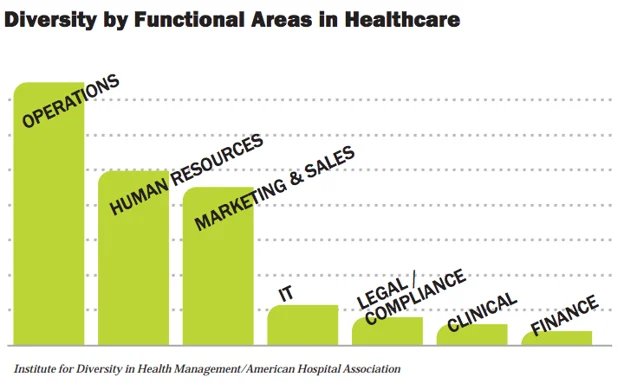
Diversity and Inclusion: A Guide for Action
When it comes to diversity and inclusion you need more than just some language in your mission and vision statement. Creating a measurable plan to increase diversity and promote positive inclusion of all backgrounds and cultures is key to supporting and encouraging a diverse culture at your organization.
- Why Diversity is Important
- Increasing Diversity in the Workplace
- Supporting Diversity and Inclusion
- Creating a Diversity Action Plan
- Experiences in Developing Diverse Teams
- Diversity Management
- Diversity and Inclusion Best Practices
Why Diversity is Important
Diverse organization have been shown to produce better overall results – increased productivity, higher revenue and profitability. Having a diverse team means having more diversity of thought and a better mix of backgrounds and experience, which leads to better ideas and strategies for achieving success.
Diversity isn’t simply a “best practice” in leadership. It’s a fundamental, essential practice that enables an organization to function at its peak capacity and innovate in unforeseen ways.
By 2055 the U.S. will not have a single racial or ethnic majority. It’s imperative that we welcome people’s cultural contributions … wherever they come from. Both ethnic and gender diversity cut to the core of our shared experience and the new business model that strategist and author Bryan Kramer calls “Human to Human” – H2H has replaced B2B and B2C as the standard for how we interact.
It’s imperative that healthcare be a leader in these areas. To provide the very best care, leaders must reflect the communities they serve. Internally, diversity in leadership also provides the entire staff with leaders that all team members can identify with, providing paths to retention and reducing the costly chore of replacing talent.
A better business model
Patients are at the center of our worldview in healthcare. The Joint Commission and the Commonwealth Fund, among others, have noted that patient-centered care requires cultural competence and linguistically appropriate services for effective communication. These aims cannot be accomplished without a commitment to diversity.
It is true that our healthcare institutions must be able to financially survive as businesses to achieve these objectives. Diversity can help ensure those goals are met as well. Recent studies by Sodexo and McKinsey have reinforced the fact that ethnic and gender diversity help businesses operate optimally and succeed financially.
Through education, advocacy and continued involvement with key minorityfocused healthcare associations, Furst Group is determined to address the disparity that ethnic minorities represent less than 2 percent of senior management positions in the healthcare industry. By comparison, in the past year, 16 percent of the executives placed by Furst Group are ethnically or racially diverse.
The situation is serious for women leaders as well. A 2015 report by CNNMoney found women hold only 14.2 percent of the top five leadership roles at companies listed in the S&P 500. “Corporate America,” CNN concluded, “has few female CEOs, and the pipeline of future women leaders is alarmingly thin.”
Thus, a strategic focus for us at Furst Group is recruiting, developing and retaining leadership teams to address the changing workforce that a global economy demands. Our placement record demonstrates that commitment. We also seek to promote diversity through our longtime sponsorship of the Top 25 Minority Executives in Healthcare and the Top 25 Women in Healthcare awards for Modern Healthcare.
Read our article about how diverse teams deliver innovation, success and profitability.

Increasing Diversity in the Workplace
In our conversations with these leaders, who have overcome many barriers themselves, it’s evident how lack of diversity even affects patient care.
As a board member of the American Hospital Association and chair of its Equity of Care Committee, Eugene Woods has an opportunity to see up close how health disparities affect far too many people in the U.S. “We know beyond a shadow of a doubt that significant inequities exist,” the Christus president and COO says, noting a recent study by the Institute for Diversity in Management that indicated only 22 percent of hospitals have utilized data to identify disparities in treatment and/or outcomes between racial or ethnic groups by analyzing one or more of the following: clinical quality indicators, readmissions or CMS core measures.
The changing population of the U.S. also requires organizations to adjust, adds Dignity CEO Lloyd Dean. “The demographics of this country are changing,” he said. “There are more minorities, and we need to ensure we have leadership that is representative of the nation and of our communities.”
Helping organizations progress
Many organizations desire to develop or maintain a diverse work force, but few fully understand that it requires a multi-faceted strategy focused on recruitment, retention, leadership development, promotional advancement, and mentoring to make it a reality.
Leaders and boards must be willing to look beyond a candidate’s ability to merely line up with a job description and also strategically assess candidates based upon professional competence and future potential.
Secondly, for a diversity strategy to be successful, it must have metrics that are linked to leadership’s performance incentives.
Our experience with and sensitivity to these issues help our clients make strategic and sensible hiring decisions. We are actively involved with the National Association of Health Service Executives (NAHSE), a non-profit association of African-American healthcare executives, as well as other key minorityfocused healthcare organizations that all serve to complement our scope.
We sponsor the Modern Healthcare awards honoring the Top 25 minority and women leaders to raise awareness, champion role-model organizations, and to serve as advocates for the richness that diversity brings to healthcare governance. The networking, mentoring and counsel that our leadership team provides to executives of all backgrounds in the industry ensure that our clients have access to a deep and diverse pool of talent.
The executives we discover and nurture on behalf of our clients make decisions that affect the lives of thousands of families and communities across the country and throughout the world. That is a responsibility we take seriously. We are committed to diversity and the mission of healthcare, and assist our client partners in becoming exemplary global leaders of these principles and practices.

What diverse executives are looking for:
- Equal consideration, treatment, and ethics
- Is leadership adopting and communicating diversity and inclusion messaging throughout the organization?
- Do the organization’s marketing materials reflect a culture of diversity and inclusion?
- Retention rate for officer-level ethnically diverse talent
- Is there a diversity and inclusion statement that is also a part of organization’s core guiding principles and values?
- Is there a performance metric tied to annual performance to ensure senior leaders are demonstrating skills in recruiting, hiring, promoting and retaining ethnically diverse talent?

Supporting Diversity and Inclusion
Diversity is a form of appreciating the difference in individuals. The differences can be based on gender, age, sex, ethnicity, sexual orientation, social status, physical abilities, culture and much more. A diverse environment is one that includes different types of people in an organization and creates conditions for all people to operate.
Creating common definitions and understanding of diversity and inclusion is key to driving more diversity within your organization. By starting from common understanding, you can begin to define what improvement in this area looks like for your workplace environment. Maybe you don’t have much diversity of talent in your organization. Maybe you have a lot. Either way there are sure to be improvements needed in how you support ongoing diversity and inclusion efforts.
Creating a Diversity Action Plan
Acknowledge where you are in the process – everyone is in a different place, but realizing where you are and where you want to be and how to get there is the most important step in making real progress on diversity. Creating a diversity action plan is a process, a journey – orienting your organization to these thoughts. Exposure inside and outside of the workplace and making sure you are okay with not knowing everything. The main driver is having the curiosity and the motivation to pursue action related to diversity and inclusion.
Creating your diversity action plan:
Start the dialogue about diversity and inclusion where you are
Design a strategic outreach and recruitment initiative to reach all segments
Create an internal Diversity and Inclusion Council inclusive of clinicians, administrators, and front line staff to evaluate and monitor progress and support employee engagement
Promote effective communication with employees and stakeholders to heighten awareness of diversity and inclusion issues and share best practices
Promote diversity, inclusion, and equity in leadership development programs and continual learning
Set a path to demonstrate leadership commitment and accountability to diversity and inclusion
Find out more about creating a diversity action plan here.

Janet Liang
Priming the pipeline for success: Janet Liang outlines the key to creating a strong bench of talent for organizational stability

Saurabh Tripathi
Leading the change with conviction: At Fresenius, Saurabh Tripathi looks for leaders who are adaptable

Beverly Malone
Beverly Malone sees healthcare's volatility as a prime opportunity to let her leadership team innovate

Sachin Jain
Transitioning to CEO? Self-awareness is vital, says CareMore CEO Sachin Jain

Jaewon Ryu
Leadership development and experiences construct a strong foundation for Jaewon Ryu

Leana Wen
Decisive leadership: Baltimore Health Commissioner Leana Wen sees the ER as a valuable training ground for physician leaders

Tracy Carter
MetroHealth chief lobbyist Tracy Carter outlines 3 key traits for mission-focused executives

SreyRam Kuy
SreyRam Kuy's field guide to developing physician leaders and diverse teams
Diversity Management
Many organizations desire to develop or maintain a diverse work force, but few fully understand that it requires a multi-faceted strategy focused on recruitment, retention, leadership development, promotional advancement, and mentoring to make it a reality. Once you’ve got a solid plan and strategy in place managing that initiative is critical.
By measuring the effectiveness of your diversity and inclusion program, you can begin to create real change within your organizations. Assessing how your program is doing against its goals allows you to further define and adjust your program. Creating a diversity and inclusion program isn’t something you can just launch and walk away from, it must be embedded in every aspect of your business. Ensuring success in any business goals means that you must align your talent goals with your business goals – diversity goals are no different.

Diversity and Inclusion Best Practices
As you develop a diversity action plan, you’ll want to outline best practices for your organization and the individuals on your team. These will be different for every company and organization, but below we outline some general best practices and responsibilities.
Organizational Best Practices
Adopting a more diverse definition of diversity
Using technology like AI to avoid unconscious bias
Sourcing candidates with non-traditional credentials
Testing diversity initiatives with data
Standardizing the interview process to reduce bias
Talent Pipelining e.g. NAHSE, ALHE, AHLF, HBCUs (Texas Southern, Prairie View A&M University), Bluford Leadership Institute, fellowship programs, etc.
Employee referral incentive programs
Develop Career Pathways for managers and above
Individual Responsibilities
- Develop skills to assess culture and work to integrate more diverse practices
- Learn about the ways of others and be willing to see past stereotypes
- Suspend judgment
- Remember that individuals are unique even within groups
- Explore, understand and honor cultural definitions and values
- Compare & evaluate culture(s) within the context of professional obligations
- Deal with dissonance that occurs by “honoring and setting aside”
- Accept responsibility to lead the conversation: be comfortable being vulnerable

